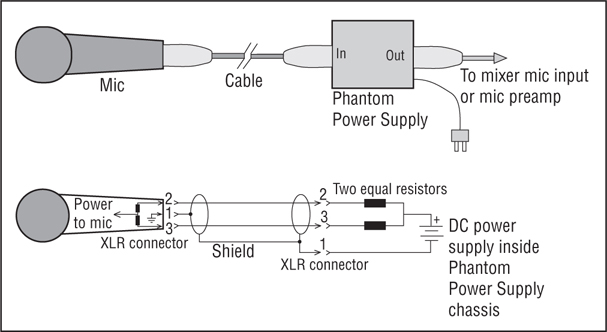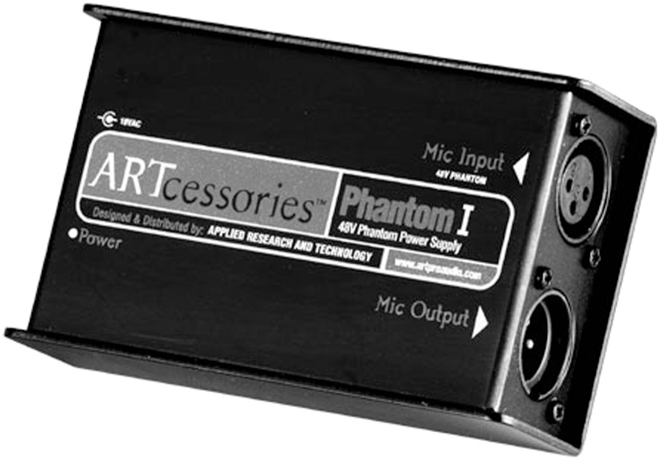Appendix D
Phantom Power Explained
Most condenser microphones need phantom power to operate their internal circuitry. Let’s explain what phantom power is and how to use it.
DEFINITION
Phantom power is electrical power that is sent to a condenser mic through its mic cable. The cable must have XLR connectors to pass phantom power.
Each of these devices can provide phantom powering:
• A mic preamp with phantom power built in
• A mixing console with phantom power built in
• A standalone phantom power supply
In each device above, a female XLR mic connector supplies the phantom power to operate the mic. The microphone receives power from, and sends audio to, the device along the same cable. It’s called “phantom” because the power does not need a separate wire; it’s “hiding” in the mic signal wires inside the mic cable.
Technically, phantom power is a positive voltage (12–48 V DC) on XLR pins 2 and 3 with respect to pin 1. The cable shield is connected to the phantom-power ground.
Figure D.1 shows a microphone plugged into a standalone phantom power supply.
FIGURE D.1 Phantom power circuit.

After you plug a condenser mic into a mixer, turn on phantom power in the mixer. The phantom on/off switch in many consoles is labeled “P48” to mean “phantom power 48 volts.”
USING A STANDALONE SUPPLY
What if your mixer or mic preamp does not have phantom power? You can buy a phantom power supply (Figure D.2) from a dealer or online.
FIGURE D.2 An example of a single-channel, standalone phantom power supply.

Connect the supply in series with the mic cable. The supply has XLR input and output connectors, one pair per channel. As shown in Figure D.1, connect a mic cable between your microphone and the supply’s input connector. Plug another mic cable between the supply’s output connector and your mixer or preamp mic input.
Some supplies are AC powered, some are battery powered, and some are both. Some can power a single microphone; others can power several at once.
CAUTIONS FOR USE
Don’t plug a mic into an input with phantom already switched on, or you’ll hear a loud pop. If you have no choice (as during a live concert), mute the mic channel when you plug the mic in.
Make sure your phantom voltage is adequate for your microphones. Check the mic’s datasheet under the “Powering” spec. Some mics start to distort or lose level if the phantom voltage drops much below 48 volts.
DC BIAS
Some microphones or mic capsules work on “DC bias” rather than phantom power. A separate wire supplies a voltage to the mic capsule. This system is used in the cable between a mic capsule and an XLR connector in lavalier mics, choir mics, and clipon instrument mics. The mic capsule itself runs off DC bias, while the XLR connector houses a circuit that runs off phantom power. That circuit converts phantom power to DC bias for the mic capsule.
